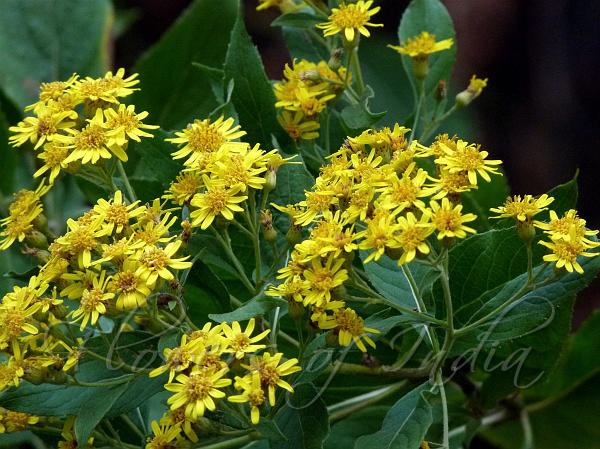|
| Lanceleaf Inula |
|

|

| File size | 753105 |
| Original date | 10/25/12 4:27 PM |
| Resolution | 2048 x 1536 |
| Flash | Flash did not fire, auto |
| Focal length | 108.0mm |
| Exposure time | 1/100s |
| Aperture | 5.2 |
| Focus Distance | |
| Metering Mode | Multi-segment |
| Camera make | Panasonic |
| Camera model | DMC-FZ40 |
| Sensor type | OneChipColorArea |
|
|
|
|
Photo: |
Botanical name: Duhaldea cuspidata Family: Asteraceae (Sunflower family)
Synonyms: Inula cuspidata, Helenium cuspidatum, Inula polycephala
Synonyms: Inula cuspidata, Helenium cuspidatum, Inula polycephala
Lanceleaf Inula is a shrub which grows on the slopes of
deep, wet valleys in the Himalayas.
Stems are 45-100 cm high, young branches
velvet-hairy. Leaves are elliptic, ovate-lanceshaped, pointed or shortly
tapering, rough on the upper surface, thinly velvet-hairy outer
lower surface, stalked with up to 1.5 cm long leaf-stalk. Flower-heads are
borne in branch-end corymbs, 0.7-1 cm in diameter, stalked.
Flower-cluster-stalk are 6 cm long, slender. Ray florets are strap-shaped,
up to 1 cm long; ligule up to 4 mm, abruptly narrowed; 3-lobed, 5-ribbed;
ribs prominent. Disc florets are up to 9 mm long, 5-lobed; lobes recurved.
Involucral bracts are in 2-3 whorls; the outer linear-oblong, 2-3 mm long,
hairy on upper surface, midrib prominent; the inner pale, linear, pointed
or shortly tapering, 5-6 mm long, appressed hairy. Achenes are dirty white,
2 ridged up to 2 mm, silky hairy. Pappus up to 5 mm long; hairs fringed
or feathery at tip. Lanceleaf Inula is found in the Himalayas, at alitudes
of 300-2100 m, from Kashmir, Himachal Pradesh, Uttarakhand to NE India and
China. Flowering: June-October.
Medicinal uses: Traditionally, the plant is used for the
treatment of dyspepsia and colic. Studies on the essential oil
obtained from the leaves showed antifungal activity. The leaf extract of
the plant showed anti-inflammatory, and significant antibacterial and
antifungal activities.
Traditionally, the plant is used for the
treatment of dyspepsia and colic. Studies on the essential oil
obtained from the leaves showed antifungal activity. The leaf extract of
the plant showed anti-inflammatory, and significant antibacterial and
antifungal activities.
Medicinal uses:
 Traditionally, the plant is used for the
treatment of dyspepsia and colic. Studies on the essential oil
obtained from the leaves showed antifungal activity. The leaf extract of
the plant showed anti-inflammatory, and significant antibacterial and
antifungal activities.
Traditionally, the plant is used for the
treatment of dyspepsia and colic. Studies on the essential oil
obtained from the leaves showed antifungal activity. The leaf extract of
the plant showed anti-inflammatory, and significant antibacterial and
antifungal activities.
| Identification credit: Gajendra Rawat | Photographed in Mussoorie, Uttarakhand. |
• Is this flower misidentified? If yes,